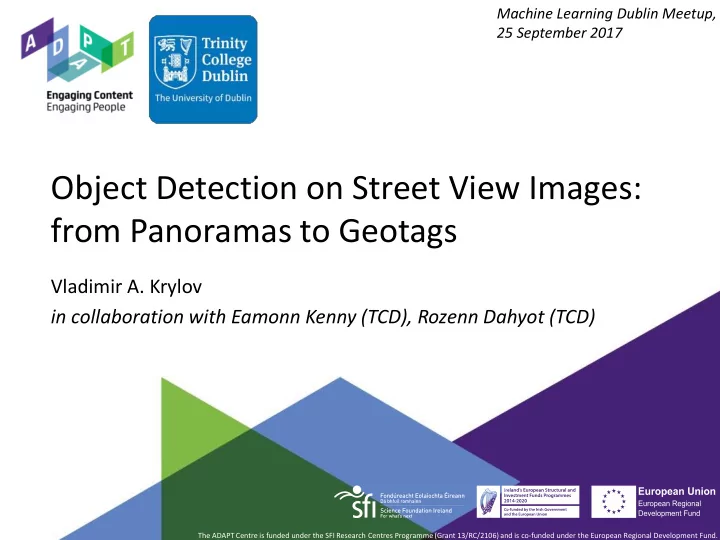

Machine Learning Dublin Meetup, 25 September 2017 Object Detection on Street View Images: from Panoramas to Geotags Vladimir A. Krylov in collaboration with Eamonn Kenny (TCD), Rozenn Dahyot (TCD) The ADAPT Centre is funded under the SFI Research Centres Programme (Grant 13/RC/2106) and is co-funded under the European Regional Development Fund.
Object detection. Intro. www.adaptcentre.ie ➢ Motivation . Billions of images (by Google , Bing , Mapillary ) covering mlns of kms of road. ~1 mln km coverage >500 km 490km
Object detection. Intro. www.adaptcentre.ie ➢ Motivation . Billions of images (by Google , Bing , Mapillary ) covering mlns of kms of road. ➢ Target . Automatic mapping of stationary recurring objects from Street View .
Object detection. Intro. www.adaptcentre.ie ➢ Motivation . Billions of images (by Google , Bing , Mapillary ) covering mlns of kms of road. ➢ Target . Automatic mapping of stationary recurring objects from Street View. ➢ State-of-the-art : Object recognition. Mapillary Vistas Dataset
Object detection. Intro. www.adaptcentre.ie ➢ Motivation . Billions of images (by Google , Bing , Mapillary ) covering mlns of kms of road. ➢ Target . Automatic mapping of stationary recurring objects from Street View. ➢ State-of-the-art : Object recognition. Image geolocation . Lin T. et al., CVPR 2015 Weyand T. et al., ECCV 2016
Object detection. Intro. www.adaptcentre.ie ➢ Motivation . Billions of images (by Google , Bing , Mapillary ) covering mlns of kms of road. ➢ Target . Automatic mapping of stationary recurring objects from Street View. ➢ State-of-the-art : Object recognition. Image geolocation. Object geolocation . Wegner, J. et al., CVPR 2016
Processing pipeline: semantic segmentation www.adaptcentre.ie ➢ Object detection: Semantic segmentation with Fully Convolutional NNs : • Introduce extra FP penalty • Retrain on one or multiple classes of objects: on Mapillary Vistas, Cityscapes Shelhamer E. et al., IEEE T-PAMI 2017
Processing pipeline: monocular depth estimation www.adaptcentre.ie ➢ Spatial scene analysis: • Stereo-vision, Structure-from-Motion o Requires more data, assumptions. • Monocular depth estimation o Provides approximate accuracies; o Requires segmented objects. Laina I. et al., 3d Vision 2016
Processing pipeline: geotagging www.adaptcentre.ie ? ➢ Strategies to estimate the position of objects from images: • • Depth-based Triangulation-based GSV position 1 Object GSV position 2 ✓ Single view: sensitivity ✓ High accuracy ✓ Single view: false positives ✓ Multiple views ✓ Low accuracy: up to 7m error ✓ Matching required
Processing pipeline: geotagging www.adaptcentre.ie ➢ We define a Markov Random Field (MRF) model over the space of all view-rays intersections: • label z=0 if not occupied by object • label z=1 if occupied ➢ MRF configuration is characterized by its corresponding energy U . Optimal = minimum of U. Energy terms: o Unary term. Consistency with depth. o Pairwise term. No occlusions. No spread. Δ – depth estimates o Ray term. Penalize not matched rays. d – triangulated distances x – Euclidean intersections Total energy:
Processing pipeline: geotagging www.adaptcentre.ie ➢ The geotagging is performed as follows: ✓ Calculate the space of all intersections; ✓ Optimize the MRF model; ✓ Discard non-paired instances; ✓ Cluster the results. Take intra-cluster averages: • Sparsity assumption .
Processing pipeline: OVERVIEW www.adaptcentre.ie Object detection pipeline: ➢ DL: pixel-level segmentation to identify objects; ➢ DL: monocular depth (camera-to-object distance) estimation: • max distance from camera: 25m; ➢ GPS-tagging based on triangulation and Markov Random field model: • mild object sparsity assumption - 1m apart; ➢ Clustering.
Results: traffic lights www.adaptcentre.ie ➢ Geotagging of traffic lights in Regent str., London, UK: • 87 GSV panoramas, 47 out of 50 objects discovered (94% recall) Map view: Quantitative performance:
Results: DEMO www.adaptcentre.ie ➢ Geotagging of telegraph poles over a 2km road, co. Kildare: • 170 GSV panoramas, 37 out of 38 objects discovered (97.4% recall) ➢ We gratefully acknowledge financial support and expertise of eir in producing these results
Conclusions www.adaptcentre.ie We have developed an image processing pipeline that: ➢ Is fully automatic ; ➢ The geotagging accuracy comparable with commercial-range GPS-unit; ➢ Detects and geotags objects at approx. 1.1 GSV panorama per second rate ( ~3.000 km in 24h on a desktop PC with 2 GPUs); ➢ Can accommodate custom detection and depth estimation modules. 490km
www.adaptcentre.ie Thank you! Contact Us O'Reilly Building Trinity College Dublin Dublin 2 Ireland adaptcentre.ie
Recommend
More recommend